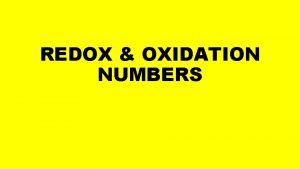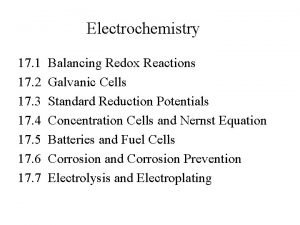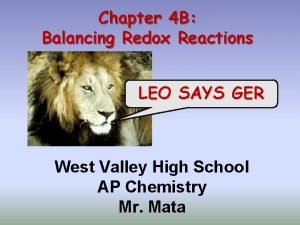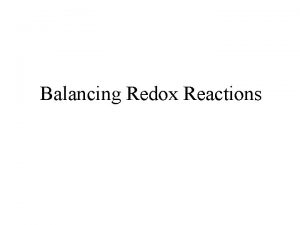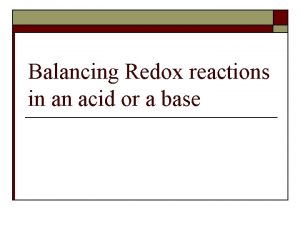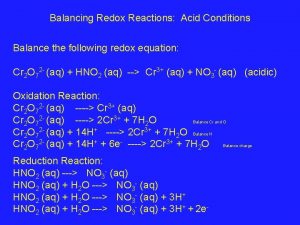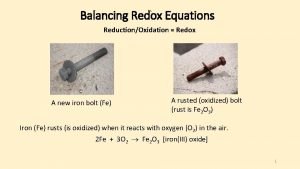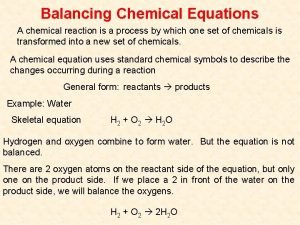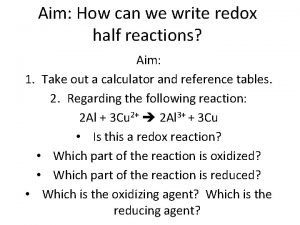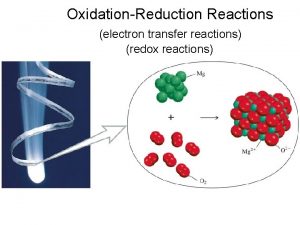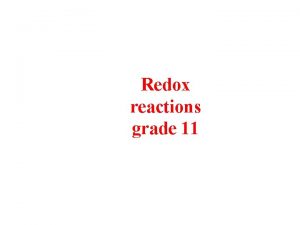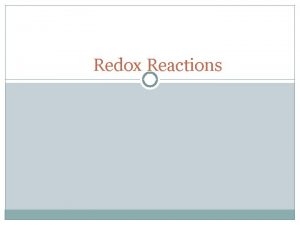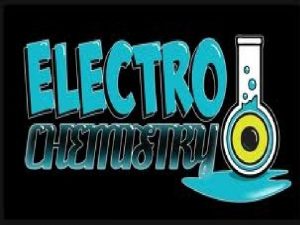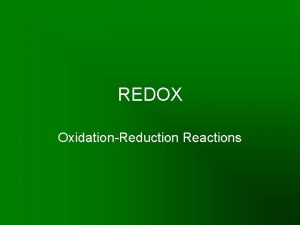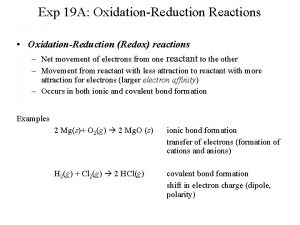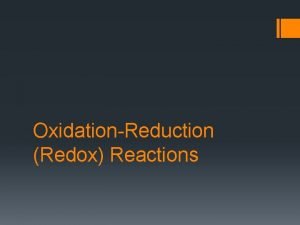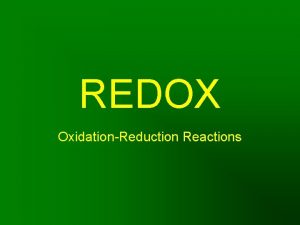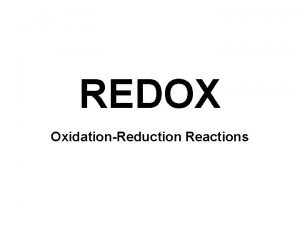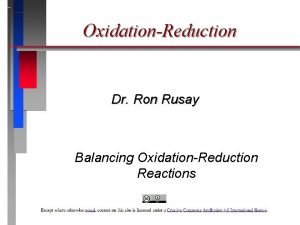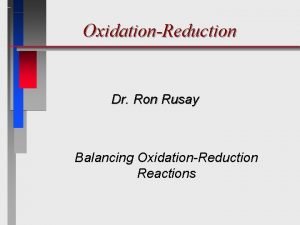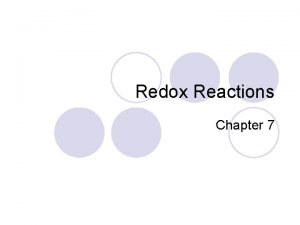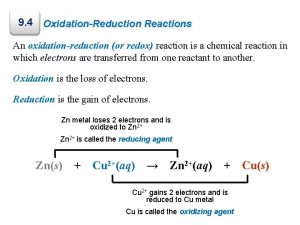Redox Reactions Chapter 4 Redox Reactions l OxidationReduction














- Slides: 14

Redox Reactions Chapter 4

Redox Reactions l Oxidation-Reduction (Redox) Reactions l Redox reactions involve an electron transfer. l These reaction occur between metals and nonmetals. l Ionic reactions are redox reactions.

The name l There are two parties in a redox reaction. l The one that is gaining electron(s). l This one gets reduced. l Think of the charge, it gets lower. l The one that is losing electron(s). l It gets oxidized.

Oil Rig l Oxidation l Is l Losing an electron l Reduction l Is l Gaining an electron

What makes this a redox reaction? l Follow the electron l Ag. Cl + Cu Ag + Cu. Cl l Ag+ + Cl- + Cu Ag + Cl- +Cu+ e- l Copper starts out neutral, Ag is +, Cl is -. The compound is neutral but they still have their charges l Then the reaction. l Copper gives an electron to silver making silver neutral, and copper positive.

Combustion Reaction l A chemical reaction involving oxygen that produces energy (heat) so rapidly that it produces a flame. l CH 4 + O 2 CO 2 + H 2 O l Natural gas combusting. Used for Bunsen burners, gas stoves, gas furnaces etc. l C 8 H 18 + O 2 CO 2 + H 2 O l Combustion of octane (gasoline) l H 2 + O 2 H 2 O l Combustion of hydrogen, used in a fuel cell

4 general forms of reactions l Almost all reactions can fit into one of 4 general forms l Single replacement l Double replacement l Synthesis l Decomposition

Single Replacement Reaction l Your book calls this a single displacement reaction. l ~an atom or group switches its partner l AX + B A + BX l Ag. Cl + Zn Ag + Zn. Cl l Cu. SO 4 + Fe Fe. SO 4 + Cu l Fe. O + Al 2 O 3 + Fe

Double Replacement Reaction l ~two atoms or groups switches their partners l AX + BY AY + BX l 2 Ni. NO 3 + Ca. SO 4 Ca(NO 3)2 + Ni 2 SO 4 l Na. Cl + Ag. I Na. I + Ag. Cl l All of the precipitation reactions/net ionic equations we have been doing have been double replacement reactions.

Synthesis (combination) Reactions l ~simpler molecules build together and form more complex molecules l. A + B X l 6 CO 2 + 6 H 2 O C 6 H 12 O 6 + 6 O 2 l 4 Zn + O 2 2 Zn 2 O

Decomposition Reactions l ~more complex molecules break apart to form simpler molecules l. X A + B l C 6 H 12 O 6 + 6 O 2 6 CO 2 + 6 H 2 O l 2 H 2 O 2 H 2 + O 2

Reactions don’t fit into just one category l Most fit into several of these. l 2 H 2 + O 2 2 H 2 O l This is a combustion reaction, and a synthesis reaction. l All reactions be classified as one of the 4 general forms: single replacement, double replacement, synthesis or decomposition

Identify the form of the reaction l l l l Mg + 2 HNO 3 Mg(NO 3)2 + H 2 Single replacement (Redox) C 8 H 18 + O 2 CO 2 + H 2 O Decomposition (Combustion) Fe. O + HCl Fe. Cl 2 + H 2 O Double replacement (Acid Base) Fe + O 2 Fe 2 O 3 Synthesis (combustion)

Continued l K 3 PO 4 + Ca(SO 4) K 2 SO 4 +Ca 3(PO 4)2 l Double replacement (redox, precipitation) l Fe + HCl H 2 + Fe. Cl 2 l Single replacement (acid base) l C 3 H 5(NO 3)3 N 2 + O 2 + CO 2 + H 2 O l Decomposition (redox) l Cu + O 2 Cu. O l Synthesis (redox)
 Reduction half reaction
Reduction half reaction Oxidation reduction reactions chapter 19 review
Oxidation reduction reactions chapter 19 review Types of redox reactions
Types of redox reactions Oilrig redox
Oilrig redox Balancing aqueous solutions
Balancing aqueous solutions Half equations redox
Half equations redox Zn cu
Zn cu Redox reaction example
Redox reaction example Leo says ger
Leo says ger Balance redox reactions
Balance redox reactions Balancing redox reactions in acid
Balancing redox reactions in acid Balance redox reactions
Balance redox reactions Activity series oxidation
Activity series oxidation How to balance an equation step by step
How to balance an equation step by step How to write half reactions
How to write half reactions



